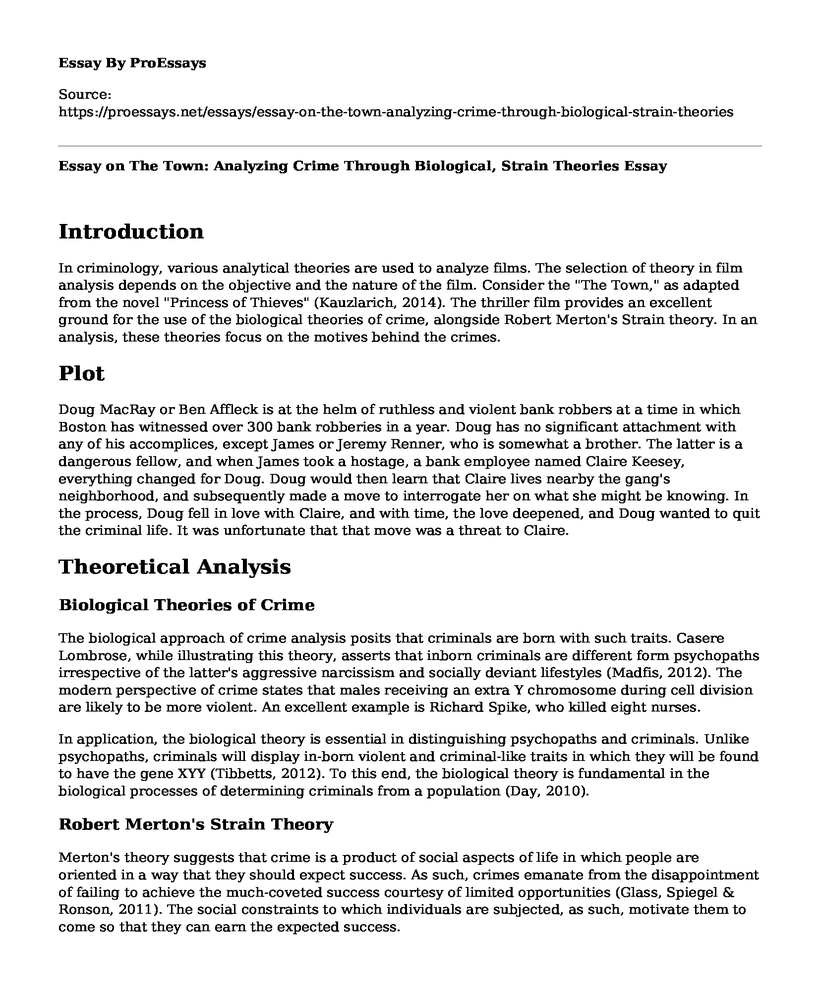Introduction
In criminology, various analytical theories are used to analyze films. The selection of theory in film analysis depends on the objective and the nature of the film. Consider the "The Town," as adapted from the novel "Princess of Thieves" (Kauzlarich, 2014). The thriller film provides an excellent ground for the use of the biological theories of crime, alongside Robert Merton's Strain theory. In an analysis, these theories focus on the motives behind the crimes.
Plot
Doug MacRay or Ben Affleck is at the helm of ruthless and violent bank robbers at a time in which Boston has witnessed over 300 bank robberies in a year. Doug has no significant attachment with any of his accomplices, except James or Jeremy Renner, who is somewhat a brother. The latter is a dangerous fellow, and when James took a hostage, a bank employee named Claire Keesey, everything changed for Doug. Doug would then learn that Claire lives nearby the gang's neighborhood, and subsequently made a move to interrogate her on what she might be knowing. In the process, Doug fell in love with Claire, and with time, the love deepened, and Doug wanted to quit the criminal life. It was unfortunate that that move was a threat to Claire.
Theoretical Analysis
Biological Theories of Crime
The biological approach of crime analysis posits that criminals are born with such traits. Casere Lombrose, while illustrating this theory, asserts that inborn criminals are different form psychopaths irrespective of the latter's aggressive narcissism and socially deviant lifestyles (Madfis, 2012). The modern perspective of crime states that males receiving an extra Y chromosome during cell division are likely to be more violent. An excellent example is Richard Spike, who killed eight nurses.
In application, the biological theory is essential in distinguishing psychopaths and criminals. Unlike psychopaths, criminals will display in-born violent and criminal-like traits in which they will be found to have the gene XYY (Tibbetts, 2012). To this end, the biological theory is fundamental in the biological processes of determining criminals from a population (Day, 2010).
Robert Merton's Strain Theory
Merton's theory suggests that crime is a product of social aspects of life in which people are oriented in a way that they should expect success. As such, crimes emanate from the disappointment of failing to achieve the much-coveted success courtesy of limited opportunities (Glass, Spiegel & Ronson, 2011). The social constraints to which individuals are subjected, as such, motivate them to come so that they can earn the expected success.
Preventing Crime in the Future
In the future, crime can be stopped by containing the primary motivational factors. For instance, the social factors that inspire crime should be revised (Day, 2010). Revising such social constraints implies that people should be subjected to the realities of life so that they can work hard to earn whatever they want to possess. Also, a biological study is essential to pinpoint the breed or individuals bearing the extra Y chromosome so that they can be contained before they get opportunities to execute criminal acts.
Conclusion
Criminal acts are inspired by factors such as biological and social aspects such as expected success. The film "The Town" exemplifies the urge to acquire substantial wealth and how it drives a group of young men into crime. As such, addressing matters like the aspiration to own substantial treasures is an excellent way of preventing future crimes. An analysis of criminal acts, criminals use theories like the biological and Merton's theory to establish factors fueling crime.
References
Day, P. (Director). (2010). Born to Rage [Television series episode]. Explorer. National Geographic. Retrieved from https://www.imdb.com/title/tt1742902/
Glass, I., Spiegel, A., & Ronson, J. (2011, May 27). "The Psychopath Test." This American Life. Retrieved from https://www.thisamericanlife.org/radio-archives/episode/436/the-psychopath-test
Kauzlarich, D. (2014). Critical Criminology. The Encyclopedia of Theoretical Criminology, 1-4. doi:10.1002/9781118517390.wbetc152
Madfis, E. (2012). Across Crimes, Criminals, and Contexts: Traps Along the Troubled Path Towards a General Theory of Crime. Critical Criminology, 20(4), 429-445. doi:10.1007/s10612-012-9159-y
Robert, Dominique. (2005). "Actuarial Justice." In M. Bosworth (Ed.) The Encyclopedia of Prisons & Correctional Facilities. Thousand Oaks, CA: Sage. Retrieved from https://books.google.co.ke/books?hl=en&lr=&id=v1w5DQAAQBAJ&oi=fnd&pg=PP1&dq=Robert,+Dominique.+(2005).+%E2%80%9CActuarial+Justice.%E2%80%9D+In+M.+Bosworth+(Ed.)+The+Encyclopedia+of+Prisons+%26+Correctional+Facilities.+Thousand+Oaks,+CA:+Sage.&ots=uJC6_eaqbk&sig=8zLJxHl9bfXau3T_-2gY_wnRNXw&redir_esc=y#v=onepage&q&f=false
Tibbetts, S. (2012). Criminological Theory: The Essentials. Thousand Oaks, CA: Sage. Retrieved from https://books.google.co.ke/books?id=XPA44ThcnJkC&pg=PR4&dq=Tibbetts,+S.+(2012).+Criminological+Theory:+The+Essentials.+Thousand+Oaks,+CA:+Sage.&hl=en&sa=X&ved=0ahUKEwjpuMXThJfmAhXPDWMBHWjvBJ0Q6AEIJzAA#v=onepage&q=Tibbetts%2C%20S.%20(2012).%20Criminological%20Theory%3A%20The%20Essentials.%20Thousand%20Oaks%2C%20CA%3A%20Sage.&f=false
Cite this page
Essay on The Town: Analyzing Crime Through Biological, Strain Theories. (2023, Mar 12). Retrieved from https://proessays.net/essays/essay-on-the-town-analyzing-crime-through-biological-strain-theories
If you are the original author of this essay and no longer wish to have it published on the ProEssays website, please click below to request its removal:
- A Discussion on the Tort Law
- War on Terrorism and Human Rights Essay Example
- The Concept of Security Essay Example
- The Sovereignty of Divine Law Over Civil Law in Antigone: Critical Essay Sample
- Essay Example on Torture in Indonesian Justice System: Stoning to Death & Human Rights
- Obama Care: US Healthcare Reforms and Its Impact - Essay Sample
- Reasons for Voting - Essay Sample







